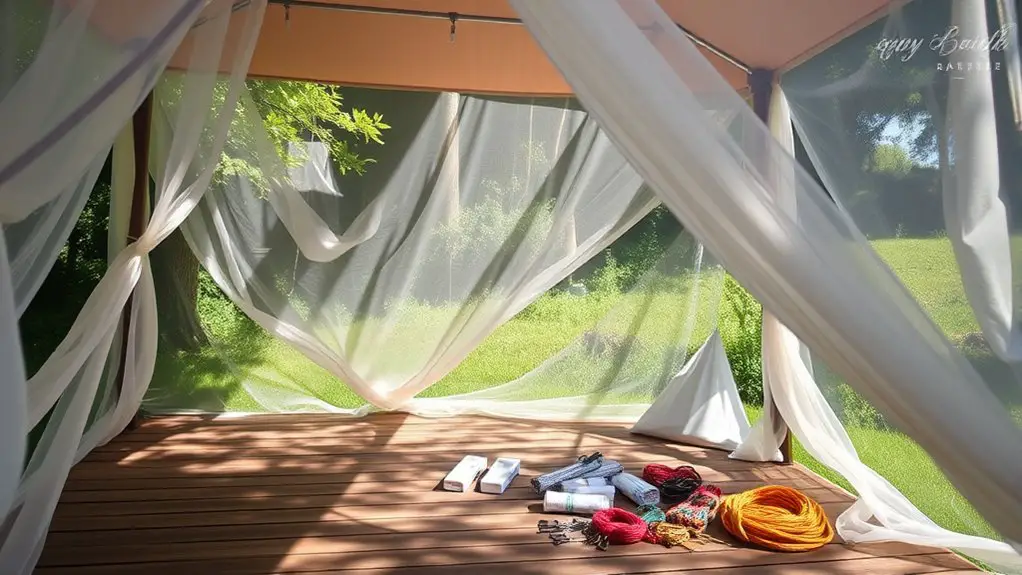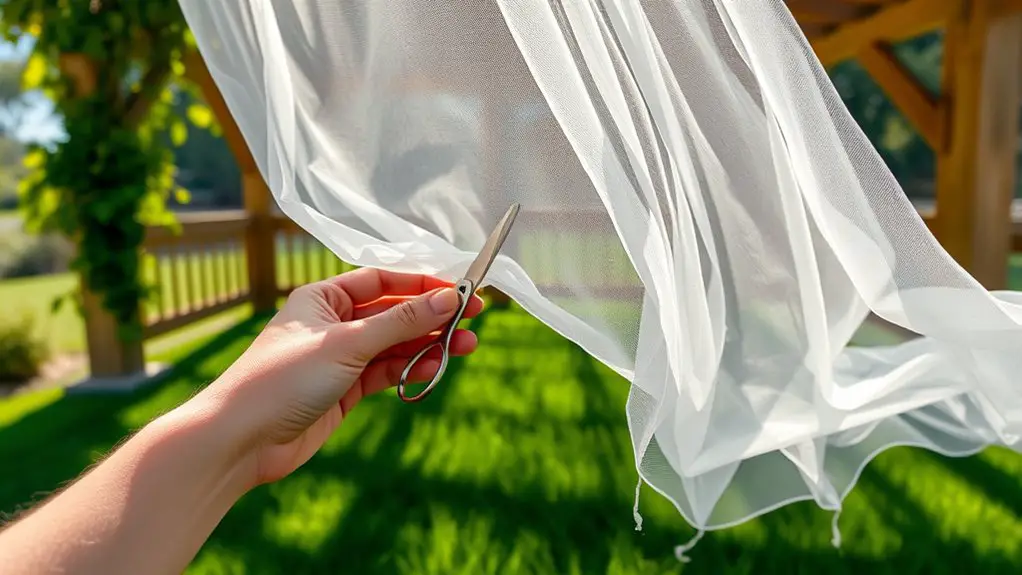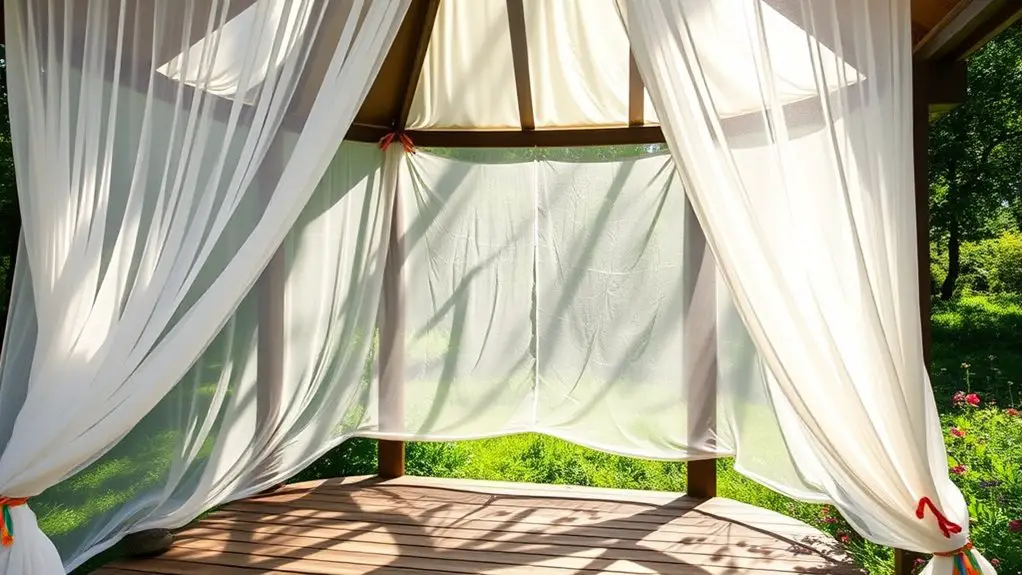To create DIY mosquito netting for your gazebo, start by choosing durable polyester or nylon fabric that lets air flow while blocking bugs. Measure your gazebo accurately, ensuring a snug fit. Cut the netting to size and attach it using clips or Velcro for easy access. Secure the edges tightly to prevent gaps and add weighted bottoms for stability during breezy nights. Enhance your setup with cozy lighting and furniture to create an inviting atmosphere. Discover more tips for enhancing your outdoor experience!
Selecting the Right Materials for Your Mosquito Netting

When you’re ready to tackle your DIY mosquito netting project, selecting the right materials is essential for both functionality and aesthetics. First, consider netting materials like polyester or nylon. These fabrics are lightweight yet durable, providing excellent protection against pesky insects while allowing for airflow. You’ll want to choose a weave tight enough to keep mosquitoes out but loose enough to let in a gentle breeze.
Next, think about fabric choices that suit your style. Opt for a neutral color to blend seamlessly with your gazebo or go bold with vibrant hues to make a statement. Remember, your netting doesn’t have to be just practical; it can enhance the beauty of your outdoor space. Additionally, ensure that the materials you select are suitable for keeping bugs out of your gazebo, as this will help maintain a serene atmosphere. Finally, verify your chosen materials are easy to clean and maintain, so you can enjoy your bug-free haven without hassle. With the right materials, your gazebo will become a serene escape in no time!
Measuring Your Gazebo for a Perfect Fit
To create the perfect mosquito netting for your gazebo, you’ll need to gather a few essential measuring tools. With a trusty tape measure in hand, you can guarantee that every inch is accounted for, allowing for a snug fit that keeps those pesky bugs out. Mastering accurate measurement techniques will set you up for success in your DIY project, so let’s get started! Additionally, ensure that your gazebo is set up in a flat, level area to facilitate accurate measurements and optimal installation.
Essential Measuring Tools
Measuring your gazebo accurately is essential for ensuring that your DIY mosquito netting fits perfectly and provides the protection you need. Start with a reliable tape measure; it’ll help you capture the dimensions of your gazebo without any guesswork. Measure each side, including the height, to account for any slopes or uneven terrain. Don’t forget to check the corners for any unique angles that might affect your netting design. A level tool can be invaluable, ensuring that all measurements are taken straight and true. This attention to detail will keep your netting snug and secure, giving you the freedom to enjoy your outdoor space without pesky interruptions. With the right tools, you’re well on your way to a bug-free haven!
Accurate Measurement Techniques
Achieving a snug fit for your mosquito netting starts with employing precise measurement techniques that cater to the unique shape of your gazebo. Begin by taking accurate measurements of each side, including height and width, making sure you account for any overhangs or unique angles. Use a flexible measuring tape to navigate curves and corners easily. For added precision, measure multiple times to confirm consistency. Don’t forget to measure the height from the ground to the top of the frame; this guarantees your netting hangs correctly. Finally, jot down your measurements, keeping them in a handy spot. With these accurate measurements in hand, you’ll be well on your way to crafting a bug-free sanctuary that enhances your outdoor freedom!
Cutting the Netting to Size

Now that you’ve measured your gazebo, it’s time to cut your mosquito netting to size. Grab some sharp scissors or a rotary cutter for clean, precise edges, and make certain to follow your measurements closely. With the right techniques, you’ll guarantee a perfect fit that keeps those pesky bugs out while letting you enjoy your outdoor space. Additionally, consider integrating durable options like polyester for added protection against the elements.
Measuring Your Gazebo Dimensions
To create a perfectly fitting mosquito net for your gazebo, start by taking accurate measurements of its dimensions. Different gazebo shapes—like octagonal, rectangular, or square—may require specific measuring techniques. Here’s a simple table to guide you through the process:
| Measurement Type | How to Measure |
|---|---|
| Height | Measure from ground to top edge |
| Width (Side to Side) | Measure across the widest part |
| Depth | Measure from front to back |
With these measurements in hand, you’ll be able to cut your netting to size, ensuring a snug fit that keeps pesky bugs at bay. Remember, precision is key to enjoying a bug-free outdoor experience, so take your time!
Cutting Techniques and Tools
With your gazebo measurements ready, it’s time to focus on cutting the netting to the precise dimensions you’ve gathered. Start by laying out your netting on a flat surface, making certain it’s free from wrinkles. For clean edges, consider using sharp scissors or a rotary cutter—both effective netting tools. If you prefer precision, a cutting mat will help protect your surface while guiding your cuts.
When it comes to cutting methods, use a straightedge to create straight lines, or opt for a pattern if you’re feeling creative. Remember to leave a little extra fabric for hems or adjustments. Taking your time now will guarantee a snug fit, giving you that bug-free haven you’re looking for. Enjoy the freedom of pest-free evenings!
Attaching the Netting to Your Gazebo
Attaching the netting to your gazebo transforms it into a bug-free sanctuary, allowing you to enjoy the outdoors without the nuisance of mosquitoes. Start by choosing the right netting types, such as lightweight polyester or thicker nylon, depending on your needs. Once you’ve got your netting, consider the best attachment methods. You can use clips, Velcro, or hooks to easily secure the netting to the gazebo frame. For a more permanent solution, sew the netting directly onto the frame or use a staple gun for a snug fit. As you work, make certain the netting drapes evenly around the structure, keeping those pesky insects out. Don’t forget to leave openings for doors or windows if you plan to use them. Additionally, securing the netting with tie-backs or clips can help prevent movement and provide stability. With these simple steps, you’ll create a comfortable, insect-free environment, perfect for relaxing evenings or lively gatherings under the stars. Enjoy your newfound freedom!
Securing the Edges to Prevent Insects From Entering

Once you’ve attached the netting to your gazebo, securing the edges becomes essential in keeping those pesky insects at bay. Start by ensuring the netting is taut, preventing gaps that little bugs can slip through. Use adhesive Velcro strips or clips to secure the corners tightly against the gazebo frame, ensuring a snug fit. You might also consider using weighted hooks or small bungee cords for extra security, especially if you’re in a breezy area.
Pay special attention to the corners, as they can be the trickiest spots for preventing gaps. By folding the netting neatly and fastening it down, you create a strong barrier that won’t easily give way. Additionally, ensure that your gazebo is constructed from weather-resistant materials to further enhance its durability against outdoor elements.
With your edges secured, you’ll feel liberated, knowing your bug-free haven is ready for relaxation. Enjoy your time outdoors without the annoyance of buzzing intruders!
Adding Weighted Bottoms for Stability
Securing the edges of your mosquito netting is an important first step, but adding weighted bottoms takes stability to the next level. By incorporating weighted materials, you’ll guarantee your netting stays in place, even during breezy evenings. Think about using small sandbags or even sewing in pockets filled with pebbles along the bottom hem of your netting. This simple addition not only prevents your net from flapping wildly but also enhances its overall durability. Securing methods like these allow you to enjoy your gazebo without the constant worry of bugs slipping through. As you lounge under the stars, you’ll appreciate the peace of mind that comes with knowing your netting is secure. Plus, by using materials that blend seamlessly into your gazebo’s aesthetic, you maintain that inviting atmosphere you love. With weighted bottoms, you can truly embrace the freedom of outdoor living, bug-free and worry-free!
Creating an Easy Access Opening
As you set up your mosquito netting, creating an easy access opening can greatly enhance your experience. Imagine stepping in and out of your cozy gazebo without fumbling or wrestling with fabric. One popular method is zipper installation, which allows for a smooth and secure entry. You can easily find zippers at your local craft store, and they’ll give you that effortless access you crave.
Alternatively, consider a flap design. This involves sewing a simple curtain-style opening that can be tied back or left to hang. With both options, you’ll enjoy freedom from pesky insects while maintaining convenience. Whichever method you choose, make sure it’s wide enough for comfortable entry, allowing you to move freely without feeling confined. By incorporating an easy access opening, you’ll elevate your outdoor experience, making it both bug-free and stress-free. Additionally, using mosquito netting in conjunction with a portable gazebo can provide enhanced protection against insects while enjoying the outdoors. So, get creative and enjoy the great outdoors!
Enhancing Your Gazebo With Additional Features
While enhancing your gazebo, you might consider adding features that not only elevate its aesthetic appeal but also improve functionality. One of the best ways to set the mood is through gazebo lighting. String lights or lanterns can create a warm, inviting atmosphere, perfect for evening gatherings. Imagine relaxing under twinkling lights while enjoying a warm breeze—it’s pure freedom!
Additionally, think about your seating arrangements. Opt for comfortable, versatile furniture that encourages conversation and relaxation. Consider cushions in vibrant colors or patterns to bring in a touch of personality. A coffee table can also enhance your space, providing a spot for drinks and snacks. Furthermore, incorporating outdoor lighting options adds a magical glow to your gazebo, making it perfect for summer evenings.
Finally, don’t forget about the landscaping around your gazebo. Adding potted plants or flowers can create a serene environment, making your outdoor retreat even more enjoyable. With these thoughtful enhancements, you’ll transform your gazebo into a haven of comfort and style!
Maintaining Your Mosquito Netting for Longevity
To guarantee your mosquito netting lasts through many seasons, regular maintenance is essential. Start with simple cleaning methods; gently wash your netting with mild soap and water to remove dirt and grime. Avoid harsh chemicals that could weaken the fabric. After cleaning, hang it to dry in a shaded area to prevent fading. Additionally, ensure to regularly clean the surrounding area to minimize debris accumulation that can cling to the netting.
Inspect your netting regularly for small tears or holes. If you find any damage, use these repair tips: a needle and thread can be your best friend for minor fixes, while fabric glue works wonders for small patches. For larger rips, consider sewing on a piece of fabric that matches your netting.
Storing your mosquito netting properly during off-seasons is also vital. Roll it up neatly and keep it in a cool, dry place to protect it from pests and moisture. With these simple steps, you can enjoy a bug-free experience for years to come!
Frequently Asked Questions
Can I Use Regular Fabric Instead of Mosquito Netting?
Fabulous fabric alternatives can offer some bug protection, but regular fabric won’t provide the same effectiveness as mosquito netting. You’d miss out on that essential barrier against pesky pests and their annoying bites.
How Do I Clean My Mosquito Netting?
To clean your mosquito netting, gently hand wash it in lukewarm water with mild detergent. Avoid harsh chemicals. Rinse thoroughly and air dry. Regular mosquito netting maintenance keeps your space bug-free and enjoyable for everyone!
What Colors Are Available for Mosquito Netting?
When it comes to color options, you’ve got a world of choices! From classic whites to vibrant greens, and even intricate design patterns, your mosquito netting can reflect your style while keeping pesky bugs at bay.
Is Mosquito Netting UV Resistant?
Yes, mosquito netting often comes with UV protection, ensuring outdoor durability. It helps shield you from harmful rays while keeping pesky bugs at bay, allowing you to enjoy your time outdoors without worry or interruption.
How Long Does Mosquito Netting Last?
Mosquito netting’s lifespan largely leans on multiple factors affecting durability. Weather, wear, and materials matter. Typically, you can expect it to last a few seasons, but proper care can prolong your peaceful, pest-free paradise.

